Synapseindia dotnet development chapter 8-0 dynamic programming
- 1. CChhaapptteerr 88 DDyynnaammiicc PPrrooggrraammmmiinngg
- 2. 2 Dynamic Programming DDyynnaammiicc PPrrooggrraammmmiinngg iiss aa ggeenneerraall aallggoorriitthhmm ddeessiiggnn tteecchhnniiqquuee ffoorr ssoollvviinngg pprroobblleemmss ddeeffiinneedd bbyy oorr ffoorrmmuullaatteedd aass rreeccuurrrreenncceess wwiitthh oovveerrllaappppiinngg ssuubbiinnssttaanncceess • IInnvveenntteedd bbyy AAmmeerriiccaann mmaatthheemmaattiicciiaann RRiicchhaarrdd BBeellllmmaann iinn tthhee 11995500ss ttoo ssoollvvee ooppttiimmiizzaattiioonn pprroobblleemmss aanndd llaatteerr aassssiimmiillaatteedd bbyy CCSS • ““PPrrooggrraammmmiinngg”” hheerree mmeeaannss ““ppllaannnniinngg”” • MMaaiinn iiddeeaa:: - sseett uupp aa rreeccuurrrreennccee rreellaattiinngg aa ssoolluuttiioonn ttoo aa llaarrggeerr iinnssttaannccee ttoo ssoolluuttiioonnss ooff ssoommee ssmmaalllleerr iinnssttaanncceess -- ssoollvvee ssmmaalllleerr iinnssttaanncceess oonnccee - rreeccoorrdd ssoolluuttiioonnss iinn aa ttaabbllee - eexxttrraacctt ssoolluuttiioonn ttoo tthhee iinniittiiaall iinnssttaannccee ffrroomm tthhaatt ttaabbllee
- 3. 3 Example: Fibonacci numbers • RReeccaallll ddeeffiinniittiioonn ooff FFiibboonnaaccccii nnuummbbeerrss:: FF((nn)) == FF((nn--11)) ++ FF((nn--22)) FF((00)) == 00 FF((11)) == 11 • CCoommppuuttiinngg tthhee nntthh FFiibboonnaaccccii nnuummbbeerr rreeccuurrssiivveellyy ((ttoopp--ddoowwnn)):: FF((nn)) FF((nn--11)) ++ FF((nn--22)) FF((nn--22)) ++ FF((nn--33)) FF((nn--33)) ++ FF((nn--44)) ......
- 4. 4 Example: Fibonacci numbers (cont.) CCoommppuuttiinngg tthhee nntthh FFiibboonnaaccccii nnuummbbeerr uussiinngg bboottttoomm--uupp iitteerraattiioonn aanndd rreeccoorrddiinngg rreessuullttss:: FF((00)) == 00 FF((11)) == 11 FF((22)) == 11++00 == 11 …… FF((nn--22)) == FF((nn--11)) == FF((nn)) == FF((nn--11)) ++ FF((nn--22)) EEffffiicciieennccyy:: -- ttiimmee -- ssppaaccee 0 1 1 . . . F(n-2) F(n-1) F(n) n n What if we solve it recursively?
- 5. 5 Examples of DP algorithms • CCoommppuuttiinngg aa bbiinnoommiiaall ccooeeffffiicciieenntt • LLoonnggeesstt ccoommmmoonn ssuubbsseeqquueennccee • WWaarrsshhaallll’’ss aallggoorriitthhmm ffoorr ttrraannssiittiivvee cclloossuurree • FFllooyydd’’ss aallggoorriitthhmm ffoorr aallll--ppaaiirrss sshhoorrtteesstt ppaatthhss • CCoonnssttrruuccttiinngg aann ooppttiimmaall bbiinnaarryy sseeaarrcchh ttrreeee • SSoommee iinnssttaanncceess ooff ddiiffffiiccuulltt ddiissccrreettee ooppttiimmiizzaattiioonn pprroobblleemmss:: -- ttrraavveelliinngg ssaalleessmmaann -- kknnaappssaacckk
- 6. Computing a binomial coefficient by DP Binomial coefficients are coefficients ooff tthhee bbiinnoommiiaall ffoorrmmuullaa:: 6 ((aa ++ bb))nn == CC((nn,,00))aannbb00 ++ .. .. .. ++ CC((nn,,kk))aann--kkbbkk + .. .. .. ++ CC((nn,,nn))aa00bbnn RReeccuurrrreennccee:: CC((nn,,kk)) == CC((nn--11,,kk)) ++ CC((nn--11,,kk--11)) ffoorr nn >> kk >> 00 CC((nn,,00)) == 11,, CC((nn,,nn)) == 11 ffoorr nn ³ 00 VVaalluuee ooff CC((nn,,kk)) ccaann bbee ccoommppuutteedd bbyy ffiilllliinngg aa ttaabbllee:: 00 11 22 .. .. .. kk--11 kk 00 11 11 11 11 .. .. .. nn--11 CC((nn--11,,kk--11)) CC((nn--11,,kk)) nn CC((nn,,kk))
- 7. 7 Computing C(n,k): pseudocode and analysis TTiimmee eeffffiicciieennccyy:: ΘΘ((nnkk)) SSppaaccee eeffffiicciieennccyy:: ΘΘ((nnkk))
- 8. 8 Knapsack Problem by DP Given n items of integer weights: w1 w2 … wn values: v1 v2 … vn a knapsack of integer capacity W find most valuable subset of the items that fit into the knapsack Consider instance defined by first i items and capacity j (j £ W). { Let V[i,j] be optimal value of such an instance. Then max {V[i-1,j], vi + V[i-1,j- wi]} if j- wi ³ 0 V[i,j] = V[i-1,j] if j- w< 0
- 9. 9 Knapsack Problem by DP (example) Example: Knapsack of capacity W = 5 item weight value 1 2 $12 2 1 $10 3 3 $20 4 2 $15 capacity j 0 0 0 0 0 12 0 1 0 1 2 22 22 22 0 10 12 22 30 32 0 10 15 25 30 37 0 1 2 3 4 5 0 w1 = 2, v1= 12 1 w2 = 1, v2= 10 2 w3 = 3, v3= 20 3 w4 = 2, v4= 15 4 ? Backtracing finds the actual optimal subset, i.e. solution.
- 10. 10 Knapsack Problem by DP (pseudocode) Algorithm DPKnapsack(w[1..n], v[1..n], W) var V[0..n,0..W], P[1..n,1..W]: int for j := 0 to W do V[0,j] := 0 for i := 0 to n do V[i,0] := 0 for i := 1 to n do for j := 1 to W do if w[i] £ j and v[i] + V[i-1,j-w[i]] > V[i-1,j] then V[i,j] := v[i] + V[i-1,j-w[i]]; P[i,j] := j-w[ i] else Running time and space: O(nW).
- 11. 11 Longest Common Subsequence (LCS) A subsequence of a sequence/string S is obtained by deleting zero or more symbols from S. For example, the following are some subsequences of “president”: pred, sdn, predent. In other words, the letters of a subsequence of S appear in order in S, but they are not required to be consecutive. The longest common subsequence problem is to find a maximum length common subsequence between two sequences.
- 12. 12 LCS For instance, Sequence 1: president Sequence 2: providence Its LCS is priden. president providence
- 13. 13 LCS Another example: Sequence 1: algorithm Sequence 2: alignment One of its LCS is algm.
- 14. 14 How to compute LCS? Let A=a1a2…am and B=b1b2…bn . len(i, j): the length of an LCS between a1a2…ai and b1b2…bj With proper initializations, len(i, j) can be computed as follows. , = = 0 if 0 or 0, len ( i - 1, j - 1) + 1 if i , j > 0 and a = b i j len i j len i j i j a b max( ( , 1), ( 1, )) if , 0 and . ( , ) ì ïî ïí - - > ¹ = i j i j len i j
- 15. 15 procedure LCS-Length(A, B) 1. for i ← 0 to m do len(i,0) = 0 2. for j ← 1 to n do len(0,j) = 0 3. for i ← 1 to m do 4. for j ← 1 to n do 5. if i j b a = then êë len i j len i j ( , ) ( 1, 1) 1 prev i j é = - - + = ( , ) " " 6. else if len(i -1, j) ³len(i, j -1) 7. then êë len i j len i j ( , ) ( 1, ) prev i j é = - = ( , ) " " len i j len i j ( , ) ( , 1) prev i j é 8. else êë = - = ( , ) " " 9. return len and prev
- 16. 16 i j 0 1 p 2 r 3 o 4 v 5 i 6 d 7 e 8 n 9 c 10 e 0 0 0 0 0 0 0 0 0 0 0 0 1 p 0 1 1 1 1 1 1 1 1 1 1 2 2 r 0 1 2 2 2 2 2 2 2 2 2 3 e 0 1 2 2 2 2 2 3 3 3 3 4 s 0 1 2 2 2 2 2 3 3 3 3 5 i 0 1 2 2 2 3 3 3 3 3 3 6 d 0 1 2 2 2 3 4 4 4 4 4 7 e 0 1 2 2 2 3 4 5 5 5 5 8 n 0 1 2 2 2 3 4 5 6 6 6 9 t 0 1 2 2 2 3 4 5 6 6 6 Running time and memory: O(mn) and O(mn).
- 17. 17 The backtracing algorithm procedure Output-LCS(A, prev, i, j) 1 if i = 0 or j = 0 then return 2 if prev(i, j)=” “ then êë Output LCS A prev i j print é - - - i a ( , , 1, 1) 3 else if prev(i, j)=” “ then Output-LCS(A, prev, i-1, j) 4 else Output-LCS(A, prev, i, j-1)
- 18. 18 i j 0 1 p 2 r 3 o 4 v 5 i 6 d 7 e 8 n 9 c 10 e 0 0 0 0 0 0 0 0 0 0 0 0 1 p 0 1 1 1 1 1 1 1 1 1 1 2 2 r 0 1 2 2 2 2 2 2 2 2 2 3 e 0 1 2 2 2 2 2 3 3 3 3 4 s 0 1 2 2 2 2 2 3 3 3 3 5 i 0 1 2 2 2 3 3 3 3 3 3 6 d 0 1 2 2 2 3 4 4 4 4 4 7 e 0 1 2 2 2 3 4 5 5 5 5 8 n 0 1 2 2 2 3 4 5 6 6 6 9 t 0 1 2 2 2 3 4 5 6 6 6 Output: priden
- 19. Warshall’s Algorithm: Transitive Closure • Computes the transitive cclloossuurree ooff aa rreellaattiioonn • AAlltteerrnnaattiivveellyy:: eexxiisstteennccee ooff aallll nnoonnttrriivviiaall ppaatthhss iinn aa ddiiggrraapphh • EExxaammppllee ooff ttrraannssiittiivvee cclloossuurree:: 19 3 2 4 1 0 0 1 0 1 0 0 1 0 0 0 0 0 1 0 0 0 0 1 0 1 11 11 1 0 0 0 0 11 1 11 11 3 2 4 1
- 20. 20 Warshall’s Algorithm Constructs ttrraannssiittiivvee cclloossuurree TT aass tthhee llaasstt mmaattrriixx iinn tthhee sseeqquueennccee ooff nn--bbyy--nn mmaattrriicceess RR((00)),, …… ,, RR((kk)),, …… ,, RR((nn)) wwhheerree RR((kk))[[ii,,jj]] == 11 iiffff tthheerree iiss nnoonnttrriivviiaall ppaatthh ffrroomm ii ttoo jj wwiitthh oonnllyy tthhee ffiirrsstt kk vveerrttiicceess aalllloowweedd aass iinntteerrmmeeddiiaattee NNoottee tthhaatt RR((00)) == AA ((aaddjjaacceennccyy mmaattrriixx)),, RR((nn)) == TT ((ttrraannssiittiivvee cclloossuurree)) 3 2 4 1 3 2 4 1 3 2 4 1 3 2 4 1 R(0) 0 0 1 0 1 0 0 1 0 0 0 0 0 1 0 0 R(1) 0 0 1 0 1 0 11 1 0 0 0 0 0 1 0 0 R(2) 0 0 1 0 1 0 1 1 0 0 0 0 11 1 11 11 R(3) 0 0 1 0 1 0 1 1 0 0 0 0 1 1 1 1 R(4) 0 0 1 0 1 11 1 1 0 0 0 0 1 1 1 1 3 2 4 1
- 21. 21 Warshall’s Algorithm (recurrence) OOnn tthhee kk--tthh iitteerraattiioonn,, tthhee aallggoorriitthhmm ddeetteerrmmiinneess ffoorr eevveerryy ppaaiirr ooff vveerrttiicceess ii,, jj iiff aa ppaatthh eexxiissttss ffrroomm ii aanndd jj wwiitthh jjuusstt vveerrttiicceess 11,,……,,kk aalllloowweedd aass iinntteerrmmeeddiiaattee RR((kk--11))[[ii,,jj]] ((ppaatthh uussiinngg jjuusstt 11 ,,……,,kk--11)) RR((kk))[[ii,,jj]] == oorr RR((kk--11))[[ii,,kk]] aanndd RR((kk--11))[[kk,,jj]] ((ppaatthh ffrroomm ii ttoo kk aanndd ffrroomm kk ttoo jj uussiinngg jjuusstt 11 ,,……,,kk--11)) i j k { Initial condition?
- 22. Warshall’s Algorithm (matrix generation) Recurrence rreellaattiinngg eelleemmeennttss RR((kk)) ttoo eelleemmeennttss ooff RR((kk--11)) iiss:: 22 RR((kk))[[ii,,jj]] == RR((kk--11))[[ii,,jj]] oorr ((RR((kk--11))[[ii,,kk]] aanndd RR((kk--11))[[kk,,jj]])) IItt iimmpplliieess tthhee ffoolllloowwiinngg rruulleess ffoorr ggeenneerraattiinngg RR((kk)) ffrroomm RR((kk--11)):: RRuullee 11 IIff aann eelleemmeenntt iinn rrooww ii aanndd ccoolluummnn jj iiss 11 iinn RR((kk--11)),, iitt rreemmaaiinnss 11 iinn RR((kk)) RRuullee 22 IIff aann eelleemmeenntt iinn rrooww ii aanndd ccoolluummnn jj iiss 00 iinn RR((kk--11)),, iitt hhaass ttoo bbee cchhaannggeedd ttoo 11 iinn RR((kk)) iiff aanndd oonnllyy iiff tthhee eelleemmeenntt iinn iittss rrooww ii aanndd ccoolluummnn kk aanndd tthhee eelleemmeenntt iinn iittss ccoolluummnn jj aanndd rrooww kk aarree bbootthh 11’’ss iinn RR((kk--11))
- 23. 23 Warshall’s Algorithm (example) 3 1 0 0 1 0 2 4 1 0 0 1 0 0 0 0 0 1 0 0 R(0) = 0 0 1 0 1 0 1 1 0 0 0 0 0 1 0 0 R(1) = 0 0 1 0 1 0 1 1 0 0 0 0 1 1 1 1 R(2) = 0 0 1 0 1 0 1 1 0 0 0 0 1 1 1 1 R(3) = 0 0 1 0 1 1 1 1 0 0 0 0 1 1 1 1 R(4) =
- 24. Warshall’s Algorithm (pseudocode and analysis) TTiimmee eeffffiicciieennccyy:: ΘΘ((nn33)) SSppaaccee eeffffiicciieennccyy:: MMaattrriicceess ccaann bbee wwrriitttteenn oovveerr tthheeiirr pprreeddeecceessssoorrss 24 ((wwiitthh ssoommee ccaarree)),, ssoo iitt’’ss ΘΘ((nn^^22))..
- 25. Floyd’s Algorithm: All pairs shortest paths Problem: In a weighted (di)graph, find sshhoorrtteesstt ppaatthhss bbeettwweeeenn 25 eevveerryy ppaaiirr ooff vveerrttiicceess SSaammee iiddeeaa:: ccoonnssttrruucctt ssoolluuttiioonn tthhrroouugghh sseerriieess ooff mmaattrriicceess DD((00)),, ……,, DD ((nn)) uussiinngg iinnccrreeaassiinngg ssuubbsseettss ooff tthhee vveerrttiicceess aalllloowweedd aass iinntteerrmmeeddiiaattee EExxaammppllee:: 3 2 4 1 4 1 6 1 5 3 0 ∞ 4 ∞ 1 0 4 3 ∞ ∞ 0 ∞ 6 5 1 0
- 26. Floyd’s Algorithm (matrix generation) OOnn tthhee kk--tthh iitteerraattiioonn,, tthhee aallggoorriitthhmm ddeetteerrmmiinneess sshhoorrtteesstt ppaatthhss bbeettwweeeenn eevveerryy ppaaiirr ooff vveerrttiicceess ii,, jj tthhaatt uussee oonnllyy vveerrttiicceess aammoonngg 11,, ……,,kk aass iinntteerrmmeeddiiaattee 26 DD((kk))[[ii,,jj]] == mmiinn {{DD((kk--11))[[ii,,jj]],, DD((kk--11))[[ii,,kk]] ++ DD((kk--11))[[kk,,jj]]}} i j k DD((kk--11))[[ii,,kk]] DD((kk--11))[[ii,,jj]] DD((kk--11))[[kk,,jj]] Initial condition?
- 27. 27 Floyd’s Algorithm (example) 0 ∞ 3 ∞ 2 0 ∞ ∞ ∞ 7 0 1 6 ∞ ∞ 0 D(0) = 0 ∞ 3 ∞ 2 0 5 ∞ ∞ 7 0 1 6 ∞ 9 0 D(1) = 2 6 7 1 2 0 ∞ 3 ∞ 2 0 5 ∞ 9 7 0 1 6 ∞ 9 0 3 D(2) = 0 10 3 4 2 0 5 6 9 7 0 1 6 16 9 0 D(3) = 0 10 3 4 2 0 5 6 7 7 0 1 6 16 9 0 D(4) = 3 1 4
- 28. Floyd’s Algorithm (pseudocode and analysis) TTiimmee eeffffiicciieennccyy:: ΘΘ((nn33)) SSppaaccee eeffffiicciieennccyy:: MMaattrriicceess ccaann bbee wwrriitttteenn oovveerr tthheeiirr pprreeddeecceessssoorrss NNoottee:: WWoorrkkss oonn ggrraapphhss wwiitthh nneeggaattiivvee eeddggeess bbuutt wwiitthhoouutt nneeggaattiivvee ccyycclleess.. SShhoorrtteesstt ppaatthhss tthheemmsseellvveess ccaann bbee ffoouunndd,, ttoooo.. HHooww?? 28 If D[i,k] + D[k,j] < D[i,j] then P[i,j] k Since the superscripts k or k-1 make no difference to D[i,k] and D[k,j].
- 29. 29 Optimal Binary Search Trees PPrroobblleemm:: GGiivveenn nn kkeeyyss aa11 << ……<< aann aanndd pprroobbaabbiilliittiieess pp11,, ……,, ppnn sseeaarrcchhiinngg ffoorr tthheemm,, ffiinndd aa BBSSTT wwiitthh aa mmiinniimmuumm aavveerraaggee nnuummbbeerr ooff ccoommppaarriissoonnss iinn ssuucccceessssffuull sseeaarrcchh.. SSiinnccee ttoottaall nnuummbbeerr ooff BBSSTTss wwiitthh nn nnooddeess iiss ggiivveenn bbyy CC((22nn,,nn))// ((nn++11)),, wwhhiicchh ggrroowwss eexxppoonneennttiiaallllyy,, bbrruuttee ffoorrccee iiss hhooppeelleessss.. EExxaammppllee:: WWhhaatt iiss aann ooppttiimmaall BBSSTT ffoorr kkeeyyss AA,, BB,, CC,, aanndd DD wwiitthh sseeaarrcchh pprroobbaabbiilliittiieess 00..11,, 00..22,, 00..44,, aanndd 00..33,, rreessppeeccttiivveellyy?? D A B C Average # of comparisons = 1*0.4 + 2*(0.2+0.3) + 3*0.1 = 1.7
- 30. 30 DP for Optimal BST Problem LLeett CC[[ii,,jj]] bbee mmiinniimmuumm aavveerraaggee nnuummbbeerr ooff ccoommppaarriissoonnss mmaaddee iinn TT[[ii,,jj]],, ooppttiimmaall BBSSTT ffoorr kkeeyyss aaii << ……<< aajj ,, wwhheerree 11 ≤≤ ii ≤≤ jj ≤≤ nn.. CCoonnssiiddeerr ooppttiimmaall BBSSTT aammoonngg aallll BBSSTTss wwiitthh ssoommee aakk ((ii ≤≤ kk ≤≤ jj )) aass tthheeiirr rroooott;; TT[[ii,,jj]] iiss tthhee bbeesstt aammoonngg tthheemm.. a Optimal BST for a , ..., a Optimal BST for k i a , ..., a k-1 k+1 j CC[[ii,,jj]] == mmiinn {{ppkk · 11 ++ kk--11 ΣΣ ppss ((lleevveell aass iinn TT[[ii,,kk--11]] ++11)) ++ jj ΣΣ ppss ((lleevveell aass iinn TT[[kk++11,,jj]] ++11))}} ii ≤≤ kk ≤≤ jj ss == ii ss ==kk++11
- 31. 31 DP for Optimal BST Problem (cont.) AAfftteerr ssiimmpplliiffiiccaattiioonnss,, wwee oobbttaaiinn tthhee rreeccuurrrreennccee ffoorr CC[[ii,,jj]]:: jj CC[[ii,,jj]] == mmiinn {{CC[[ii,,kk--11]] ++ CC[[kk++11,,jj]]}} ++ ΣΣ ppss ffoorr 11 ≤≤ ii ≤≤ jj ≤≤ nn CC[[ii,,ii]] == ppii ffoorr 11 ≤≤ ii ≤≤ jj ≤≤ nn 0 goal 0 C[i,j] 0 1 n+1 0 1 n p 1 p2 pn i j ss == ii ii ≤≤ kk ≤≤ jj
- 32. 32 Example: key A B C D probability 0.1 0.2 0.4 0.3 t The tables below are filled diagonal by diagonal: thhee lleefftt oonnee iiss ffiilllleedd uussiinngg tthhee rreeccuurrrreennccee CC[[ii,,jj]] == mmiinn {{CC[[ii,,kk--11]] ++ CC[[kk++11,,jj]]}} ++ ΣΣ ppss ,, CC[[ii,,ii]] == ppii ;; ii ≤≤ kk ≤≤ jj ss == ii tthhee rriigghhtt oonnee,, ffoorr ttrreeeess’’ rroooottss,, rreeccoorrddss kk’’ss vvaalluueess ggiivviinngg tthhee mmiinniimmaa 00 11 22 33 44 11 00 ..11 ..44 11..11 11..77 22 00 ..22 ..88 11..44 33 00 ..44 11..00 44 00 ..33 55 00 00 11 22 33 44 11 11 22 33 33 22 22 33 33 33 33 33 44 44 55 jj B ooppttiimmaall BBSSTT A C D ii jj ii jj
- 33. 33 Optimal Binary Search Trees
- 34. Analysis DP for Optimal BST Problem TTiimmee eeffffiicciieennccyy:: ΘΘ((nn33)) bbuutt ccaann bbee rreedduucceedd ttoo ΘΘ((nn22)) bbyy ttaakkiinngg aaddvvaannttaaggee ooff mmoonnoottoonniicciittyy ooff eennttrriieess iinn tthhee rroooott ttaabbllee,, ii..ee..,, RR[[ii,,jj]] iiss aallwwaayyss iinn tthhee rraannggee bbeettwweeeenn RR[[ii,,jj--11]] aanndd RR[[ii++11,,jj]] 34 SSppaaccee eeffffiicciieennccyy:: ΘΘ((nn22)) MMeetthhoodd ccaann bbee eexxppaannddeedd ttoo iinncclluuddee uunnssuucccceessssffuull sseeaarrcchheess



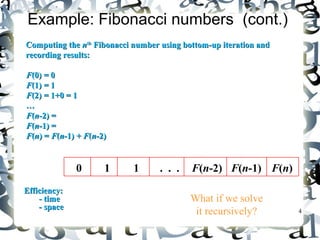

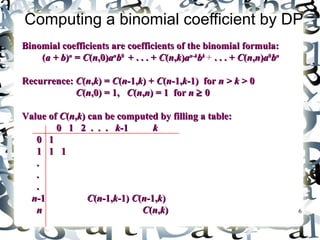

![8
Knapsack Problem by DP
Given n items of
integer weights: w1 w2 … wn
values: v1 v2 … vn
a knapsack of integer capacity W
find most valuable subset of the items that fit into the
knapsack
Consider instance defined by first i items and capacity j
(j £ W).
{
Let V[i,j] be optimal value of such an instance. Then
max {V[i-1,j], vi + V[i-1,j- wi]} if j- wi ³ 0
V[i,j] =
V[i-1,j] if j- w< 0](https://image.slidesharecdn.com/synapseindiadotnetdevelopment-chapter8-0dynamicprogramming-141127045402-conversion-gate01/85/Synapseindia-dotnet-development-chapter-8-0-dynamic-programming-8-320.jpg)

![10
Knapsack Problem by DP (pseudocode)
Algorithm DPKnapsack(w[1..n], v[1..n], W)
var V[0..n,0..W], P[1..n,1..W]: int
for j := 0 to W do
V[0,j] := 0
for i := 0 to n do
V[i,0] := 0
for i := 1 to n do
for j := 1 to W do
if w[i] £ j and v[i] + V[i-1,j-w[i]] > V[i-1,j]
then
V[i,j] := v[i] + V[i-1,j-w[i]]; P[i,j] := j-w[
i]
else
Running time and space:
O(nW).](https://image.slidesharecdn.com/synapseindiadotnetdevelopment-chapter8-0dynamicprogramming-141127045402-conversion-gate01/85/Synapseindia-dotnet-development-chapter-8-0-dynamic-programming-10-320.jpg)






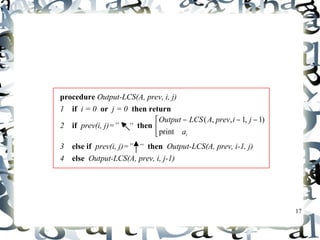


![20
Warshall’s Algorithm
Constructs ttrraannssiittiivvee cclloossuurree TT aass tthhee llaasstt mmaattrriixx iinn tthhee sseeqquueennccee
ooff nn--bbyy--nn mmaattrriicceess RR((00)),, …… ,, RR((kk)),, …… ,, RR((nn)) wwhheerree
RR((kk))[[ii,,jj]] == 11 iiffff tthheerree iiss nnoonnttrriivviiaall ppaatthh ffrroomm ii ttoo jj wwiitthh oonnllyy tthhee
ffiirrsstt kk vveerrttiicceess aalllloowweedd aass iinntteerrmmeeddiiaattee
NNoottee tthhaatt RR((00)) == AA ((aaddjjaacceennccyy mmaattrriixx)),, RR((nn))
== TT ((ttrraannssiittiivvee cclloossuurree))
3
2 4
1
3
2 4
1
3
2 4
1
3
2 4
1
R(0)
0 0 1 0
1 0 0 1
0 0 0 0
0 1 0 0
R(1)
0 0 1 0
1 0 11 1
0 0 0 0
0 1 0 0
R(2)
0 0 1 0
1 0 1 1
0 0 0 0
11 1 11 11
R(3)
0 0 1 0
1 0 1 1
0 0 0 0
1 1 1 1
R(4)
0 0 1 0
1 11 1 1
0 0 0 0
1 1 1 1
3
2 4
1](https://image.slidesharecdn.com/synapseindiadotnetdevelopment-chapter8-0dynamicprogramming-141127045402-conversion-gate01/85/Synapseindia-dotnet-development-chapter-8-0-dynamic-programming-20-320.jpg)
![21
Warshall’s Algorithm (recurrence)
OOnn tthhee kk--tthh iitteerraattiioonn,, tthhee aallggoorriitthhmm ddeetteerrmmiinneess ffoorr eevveerryy ppaaiirr ooff
vveerrttiicceess ii,, jj iiff aa ppaatthh eexxiissttss ffrroomm ii aanndd jj wwiitthh jjuusstt vveerrttiicceess 11,,……,,kk
aalllloowweedd aass iinntteerrmmeeddiiaattee
RR((kk--11))[[ii,,jj]] ((ppaatthh uussiinngg jjuusstt 11 ,,……,,kk--11))
RR((kk))[[ii,,jj]] == oorr
RR((kk--11))[[ii,,kk]] aanndd RR((kk--11))[[kk,,jj]] ((ppaatthh ffrroomm ii ttoo kk
aanndd ffrroomm kk ttoo jj
uussiinngg jjuusstt 11 ,,……,,kk--11))
i
j
k
{
Initial condition?](https://image.slidesharecdn.com/synapseindiadotnetdevelopment-chapter8-0dynamicprogramming-141127045402-conversion-gate01/85/Synapseindia-dotnet-development-chapter-8-0-dynamic-programming-21-320.jpg)
![Warshall’s Algorithm (matrix generation)
Recurrence rreellaattiinngg eelleemmeennttss RR((kk)) ttoo eelleemmeennttss ooff RR((kk--11)) iiss::
22
RR((kk))[[ii,,jj]] == RR((kk--11))[[ii,,jj]] oorr ((RR((kk--11))[[ii,,kk]] aanndd RR((kk--11))[[kk,,jj]]))
IItt iimmpplliieess tthhee ffoolllloowwiinngg rruulleess ffoorr ggeenneerraattiinngg RR((kk)) ffrroomm RR((kk--11))::
RRuullee 11 IIff aann eelleemmeenntt iinn rrooww ii aanndd ccoolluummnn jj iiss 11 iinn RR((kk--11)),,
iitt rreemmaaiinnss 11 iinn RR((kk))
RRuullee 22 IIff aann eelleemmeenntt iinn rrooww ii aanndd ccoolluummnn jj iiss 00 iinn RR((kk--11)),,
iitt hhaass ttoo bbee cchhaannggeedd ttoo 11 iinn RR((kk)) iiff aanndd oonnllyy iiff
tthhee eelleemmeenntt iinn iittss rrooww ii aanndd ccoolluummnn kk aanndd tthhee eelleemmeenntt
iinn iittss ccoolluummnn jj aanndd rrooww kk aarree bbootthh 11’’ss iinn RR((kk--11))](https://image.slidesharecdn.com/synapseindiadotnetdevelopment-chapter8-0dynamicprogramming-141127045402-conversion-gate01/85/Synapseindia-dotnet-development-chapter-8-0-dynamic-programming-22-320.jpg)
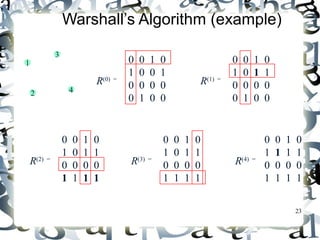

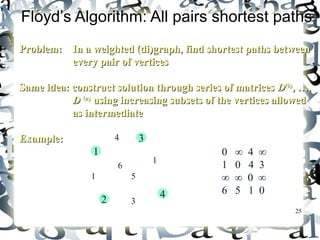
![Floyd’s Algorithm (matrix generation)
OOnn tthhee kk--tthh iitteerraattiioonn,, tthhee aallggoorriitthhmm ddeetteerrmmiinneess sshhoorrtteesstt ppaatthhss
bbeettwweeeenn eevveerryy ppaaiirr ooff vveerrttiicceess ii,, jj tthhaatt uussee oonnllyy vveerrttiicceess aammoonngg 11,,
……,,kk aass iinntteerrmmeeddiiaattee
26
DD((kk))[[ii,,jj]] == mmiinn {{DD((kk--11))[[ii,,jj]],, DD((kk--11))[[ii,,kk]] ++ DD((kk--11))[[kk,,jj]]}}
i
j
k
DD((kk--11))[[ii,,kk]]
DD((kk--11))[[ii,,jj]]
DD((kk--11))[[kk,,jj]]
Initial condition?](https://image.slidesharecdn.com/synapseindiadotnetdevelopment-chapter8-0dynamicprogramming-141127045402-conversion-gate01/85/Synapseindia-dotnet-development-chapter-8-0-dynamic-programming-26-320.jpg)
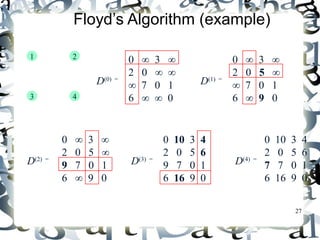
![Floyd’s Algorithm (pseudocode and analysis)
TTiimmee eeffffiicciieennccyy:: ΘΘ((nn33))
SSppaaccee eeffffiicciieennccyy:: MMaattrriicceess ccaann bbee wwrriitttteenn oovveerr tthheeiirr pprreeddeecceessssoorrss
NNoottee:: WWoorrkkss oonn ggrraapphhss wwiitthh nneeggaattiivvee eeddggeess bbuutt wwiitthhoouutt nneeggaattiivvee ccyycclleess..
SShhoorrtteesstt ppaatthhss tthheemmsseellvveess ccaann bbee ffoouunndd,, ttoooo.. HHooww??
28
If D[i,k] + D[k,j] < D[i,j] then P[i,j] k
Since the superscripts k or k-1 make
no difference to D[i,k] and D[k,j].](https://image.slidesharecdn.com/synapseindiadotnetdevelopment-chapter8-0dynamicprogramming-141127045402-conversion-gate01/85/Synapseindia-dotnet-development-chapter-8-0-dynamic-programming-28-320.jpg)

![30
DP for Optimal BST Problem
LLeett CC[[ii,,jj]] bbee mmiinniimmuumm aavveerraaggee nnuummbbeerr ooff ccoommppaarriissoonnss mmaaddee iinn
TT[[ii,,jj]],, ooppttiimmaall BBSSTT ffoorr kkeeyyss aaii << ……<< aajj ,, wwhheerree 11 ≤≤ ii ≤≤ jj ≤≤ nn..
CCoonnssiiddeerr ooppttiimmaall BBSSTT aammoonngg aallll BBSSTTss wwiitthh ssoommee aakk ((ii ≤≤ kk ≤≤ jj ))
aass tthheeiirr rroooott;; TT[[ii,,jj]] iiss tthhee bbeesstt aammoonngg tthheemm..
a
Optimal
BST for
a , ..., a
Optimal
BST for
k
i a , ..., a
k-1 k+1 j
CC[[ii,,jj]] ==
mmiinn {{ppkk · 11 ++
kk--11
ΣΣ ppss ((lleevveell aass iinn TT[[ii,,kk--11]] ++11)) ++
jj
ΣΣ ppss ((lleevveell aass iinn TT[[kk++11,,jj]] ++11))}}
ii ≤≤ kk ≤≤ jj
ss == ii
ss ==kk++11](https://image.slidesharecdn.com/synapseindiadotnetdevelopment-chapter8-0dynamicprogramming-141127045402-conversion-gate01/85/Synapseindia-dotnet-development-chapter-8-0-dynamic-programming-30-320.jpg)
![31
DP for Optimal BST Problem (cont.)
AAfftteerr ssiimmpplliiffiiccaattiioonnss,, wwee oobbttaaiinn tthhee rreeccuurrrreennccee ffoorr CC[[ii,,jj]]::
jj
CC[[ii,,jj]] == mmiinn {{CC[[ii,,kk--11]] ++ CC[[kk++11,,jj]]}} ++ ΣΣ ppss ffoorr 11 ≤≤ ii ≤≤ jj ≤≤ nn
CC[[ii,,ii]] == ppii ffoorr 11 ≤≤ ii ≤≤ jj ≤≤ nn
0 goal
0
C[i,j]
0
1
n+1
0 1 n
p 1
p2
pn
i
j
ss == ii
ii ≤≤ kk ≤≤ jj](https://image.slidesharecdn.com/synapseindiadotnetdevelopment-chapter8-0dynamicprogramming-141127045402-conversion-gate01/85/Synapseindia-dotnet-development-chapter-8-0-dynamic-programming-31-320.jpg)
![32
Example: key A B C D
probability 0.1 0.2 0.4 0.3
t The tables below are filled diagonal by diagonal: thhee lleefftt oonnee iiss ffiilllleedd
uussiinngg tthhee rreeccuurrrreennccee
CC[[ii,,jj]] == mmiinn {{CC[[ii,,kk--11]] ++ CC[[kk++11,,jj]]}} ++ ΣΣ ppss ,, CC[[ii,,ii]] == ppii ;;
ii ≤≤ kk ≤≤ jj ss == ii
tthhee rriigghhtt oonnee,, ffoorr ttrreeeess’’ rroooottss,, rreeccoorrddss kk’’ss vvaalluueess ggiivviinngg tthhee mmiinniimmaa
00 11 22 33 44
11 00 ..11 ..44 11..11 11..77
22 00 ..22 ..88 11..44
33 00 ..44 11..00
44 00 ..33
55 00
00 11 22 33 44
11 11 22 33 33
22 22 33 33
33 33 33
44 44
55
jj
B
ooppttiimmaall BBSSTT
A
C
D
ii jj
ii jj](https://image.slidesharecdn.com/synapseindiadotnetdevelopment-chapter8-0dynamicprogramming-141127045402-conversion-gate01/85/Synapseindia-dotnet-development-chapter-8-0-dynamic-programming-32-320.jpg)

![Analysis DP for Optimal BST Problem
TTiimmee eeffffiicciieennccyy:: ΘΘ((nn33)) bbuutt ccaann bbee rreedduucceedd ttoo ΘΘ((nn22)) bbyy ttaakkiinngg
aaddvvaannttaaggee ooff mmoonnoottoonniicciittyy ooff eennttrriieess iinn tthhee
rroooott ttaabbllee,, ii..ee..,, RR[[ii,,jj]] iiss aallwwaayyss iinn tthhee rraannggee
bbeettwweeeenn RR[[ii,,jj--11]] aanndd RR[[ii++11,,jj]]
34
SSppaaccee eeffffiicciieennccyy:: ΘΘ((nn22))
MMeetthhoodd ccaann bbee eexxppaannddeedd ttoo iinncclluuddee uunnssuucccceessssffuull sseeaarrcchheess](https://image.slidesharecdn.com/synapseindiadotnetdevelopment-chapter8-0dynamicprogramming-141127045402-conversion-gate01/85/Synapseindia-dotnet-development-chapter-8-0-dynamic-programming-34-320.jpg)